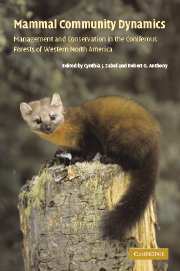 Mammal Community Dynamics
Mammal Community Dynamics Book contents
- Frontmatter
- Contents
- List of contributors
- Foreword
- Acknowledgments
- Part I Management and conservation issues for various taxa
- Part II Community and ecosystem relations
- 10 Relationships among fungi and small mammals in forested ecosystems
- 11 Ecology of coarse woody debris and its role as habitat for mammals
- 12 The ecological role of tree-dwelling mammals in western coniferous forests
- 13 The role of ungulates and large predators on plant communities and ecosystem processes in western national parks
- 14 The role of the lynx–hare cycle in boreal forest community dynamics
- 15 Associations of mammals with riparian ecosystems in Pacific Northwest forests
- Part III Conservation issues and strategies
- Index
- References
11 - Ecology of coarse woody debris and its role as habitat for mammals
Published online by Cambridge University Press: 15 December 2009
- Frontmatter
- Contents
- List of contributors
- Foreword
- Acknowledgments
- Part I Management and conservation issues for various taxa
- Part II Community and ecosystem relations
- 10 Relationships among fungi and small mammals in forested ecosystems
- 11 Ecology of coarse woody debris and its role as habitat for mammals
- 12 The ecological role of tree-dwelling mammals in western coniferous forests
- 13 The role of ungulates and large predators on plant communities and ecosystem processes in western national parks
- 14 The role of the lynx–hare cycle in boreal forest community dynamics
- 15 Associations of mammals with riparian ecosystems in Pacific Northwest forests
- Part III Conservation issues and strategies
- Index
- References
Summary
Introduction
A large western redcedar (Thuja plicata) may live to be 300 years old, and then may take another 300 years or more to decay (Embry 1963). Throughout its life and after its death, a tree can play a role in contributing to habitat quality for a succession of organisms (Maser et al. 1979) and in contributing to the quality of a site for future tree growth (Harmon et al. 1986). Trees provide cover, foraging sites, and food for many organisms, but the value of a tree to some species of mammals may only begin after the tree has died (Maser and Trappe 1984, Bartels et al. 1985, Hagan and Grove 1999).
Dead wood is a product of disturbances in forested ecosystems as well as a result of stand development (Fig. 11.1). Stands of trees typically develop following a disturbance that provides the opportunity for establishment of often more than 1000 tree seedlings per hectare (Spies and Franklin 1988). As stands develop, inter-tree competition results in mortality among those trees that are intolerant of shade or drought (Drew and Flewelling 1977, Oliver and Larson 1996). It is not uncommon to see over 90% of the trees in a stand die during the first few decades following stand establishment (Oliver and Larson 1996). Inter-tree competition mortality will continue for decades until some exogenous disturbance “thins” the stand providing the remaining trees with sufficient growing space (Agee 1999).
- Type
- Chapter
- Information
- Mammal Community DynamicsManagement and Conservation in the Coniferous Forests of Western North America, pp. 374 - 404Publisher: Cambridge University PressPrint publication year: 2003
References
- 15
- Cited by


